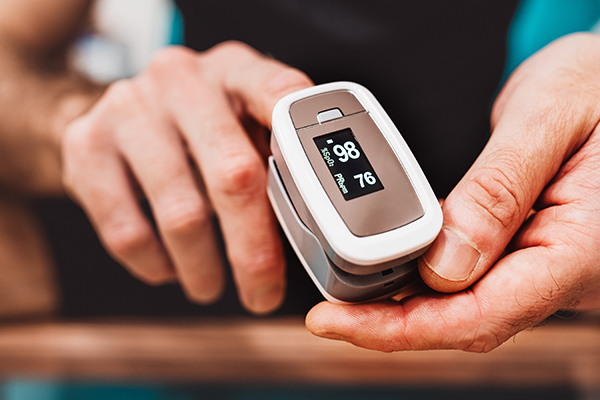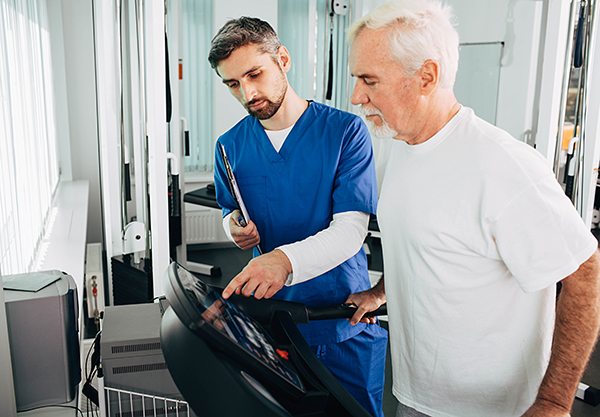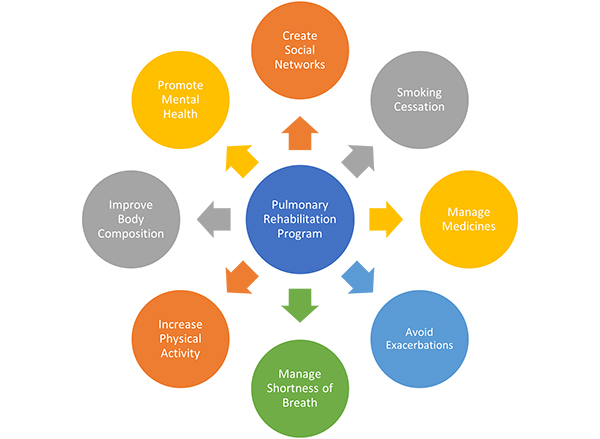Pulmonary Rehabilitation
Pulmonary rehabilitation (ree-uh-bil-uh-tAY-shuhn) (also known as pulmonary rehab) is a program for patients with chronic lung conditions. The program includes exercise, education, and support from trained health care professionals. Pulmonary rehab should be considered for anyone with bronchiectasis who has shortness of breath that prevents them from doing normal, daily activities.1 To participate in pulmonary rehab you must have a lung disease diagnosis, be referred by your doctor, and have completed a pulmonary function test (PFT).
Getting started
The first stage of a pulmonary rehab program is referred to as the “assessment.” You will answer several questions, either at home or with the pulmonary rehab coordinator. These questions tell the pulmonary rehab team about your health history and physical activity, and what difficulties you are having with daily living activities. During this stage, you will meet with the coordinator for your first education, planning, and goal setting.
You may also be asked to take a test called a 6-minute walk test. This self-paced walking test measures your fitness level at the start of the program. You may also take it again later to measure your progress. The pulmonary rehab coordinator will also decide if you need to receive oxygen while exercising. They will measure the oxygen levels in your blood and your heartrate with a pulse oximeter.2 Your balance, pace, and how tired you are will also be noted at the end of the test.

Exercise
The main part of pulmonary rehab is exercise.2 The coordinator will create an exercise plan just for you. This routine will include warm-ups, aerobic exercises, strength training, and stretching. This routine will help you increase your endurance and build muscle strength. You may be asked to use a variety of exercise machines like treadmills, stationary bikes, and step machines. You may also use hand weights, resistance bands, and weight machines. Which equipment you use will be decided by the coordinator. These choices will be based on your level of strength, range of motion, and overall goals.3 Click here to learn more about why exercise is important and to find some exercising tips.

Education
You will receive education on many topics. The coordinator will design an education plan for your specific needs and your goals for pulmonary rehab. Education will be provided either in classes or through one-on-one teaching by the pulmonary rehab staff. The main topics covered for bronchiectasis patients include (but are not limited to)3:
- Breathing retraining. Education on breathing techniques is given to patients who experience shortness of breath with activity. These techniques are practiced while exercising in pulmonary rehab.
- Airway clearance techniques. This education is provided to patients who have problems clearing mucus from their airways.
- Nutrition. Patients whose lung condition has caused either weight gain or weight loss may meet with a dietitian for nutrition counseling.
- Oxygen therapy. Patients are provided education (if needed) on long-term use of oxygen therapy, how to monitor oxygen levels, and how to troubleshoot and maintain oxygen equipment.
- Medication management. Patients are taught the proper use of medicines. This may include education on the proper use of inhalers and using inhaled medicines with airway clearance therapy.
- Smoking / vaping cessation. One-on-one counseling is offered to help patients quit smoking and/or vaping. Quitting smoking can help to slow the rate of lung function decline and reduce the number of flare-ups.4
Support
Many pulmonary rehab programs use experts on a variety of topics in their program. In addition to the educational specialists, you may also meet with mental health specialists. Mental health specialists can help with concerns about anxiety and/or depression. Occupational therapists can discuss how to use less energy during daily tasks. Doing this can help to lessen your shortness of breath during these activities.
Support group meetings allow you to get together with other patients. You can share experiences and tips for living with a lung condition. These group meetings will give you a new social network and a community of people like yourself.

In Summary
The overall goal with any pulmonary rehab program is to become more active and to learn more about your disease, treatments, and ways to cope.5 At the end of your pulmonary rehab program, you will feel more confident about how to exercise on your own. You should also feel better able to manage your lung condition so you can keep doing the daily activities that are important to you.
References:
1Pasteur M, Bilton D, Hill A, et al. British Thoracic Society guidelines for non-CF bronchiectasis. Thorax. 2010;65:i1–i58. doi: https://doi.org/10.1136/thx.2010.136119.
2Gloeckl R, Marinov B, Pitta F. Practical recommendations for exercise training in patients with COPD. Eur Respir Rev. 2013;22(128):178-186. doi: https://doi.org/10.1183/09059180.00000513.
3Hill K, Vogiatzis I, Burtin C. The importance of components of pulmonary rehabilitation, other than exercise training, in COPD. Eur Respir Rev. 2013;22(129):405-413. doi: https://doi.org10.1183/09059180.00002913.
44. Makris D, Moschandreas J, Damianaki A, et al. Exacerbations and lung function decline in COPD: new insights in current and ex-smokers. Respir Med. 2007;101(6):1305-1312. doi: https://doi.org/10.1016/j.rmed.2006.10.012.
5Ries AL, Bauldoff GS, Carlin BW, et al. Pulmonary rehabilitation: joint ACCP/AACVPR evidence-based clinical practice guidelines. Chest. 2007;131(5 Suppl):4S-42S. doi: https://doi.org/10.1378/chest.06-2418.